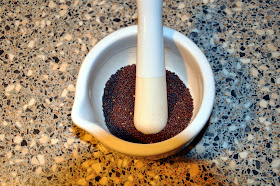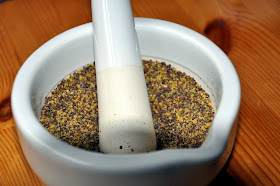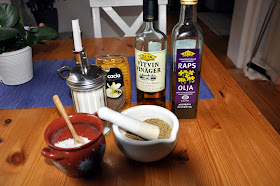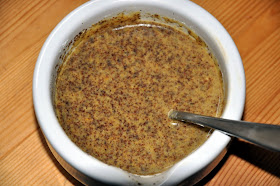--------------
Mustard is one of the oldest man made condiments there is still used widely today. Its origins are probably Roman and it was probably the the Romans who mixed unfermented grape juice, known as "must", with ground mustard seeds (called sinapis) to make "burning must", mustum ardens—hence the "must ard" in English or Moutarde in French. Other languages went back to the seed itself to give it a name. The German name is “Senf” and in the Scandinavian countries we call it Senap with some small variations in each country.
 Mustard seeds (top left) may be ground (top right) to make different kinds of mustard. The four mustards pictured are a simple table mustard with turmeric coloring (center left), a Bavarian sweet mustard (center right), a Dijon mustard (lower left), and a coarse French mustard made mainly from yellow mustard seeds (lower right).
Mustard seeds (top left) may be ground (top right) to make different kinds of mustard. The four mustards pictured are a simple table mustard with turmeric coloring (center left), a Bavarian sweet mustard (center right), a Dijon mustard (lower left), and a coarse French mustard made mainly from yellow mustard seeds (lower right). There are many variations; almost every country has a standard mustard known to everyone. In some countries it is very important in others not so much. Sometimes it’s hot and peppery, sometimes very acid or close to marmalade in sweetness. It comes in many shades, from the brightest yellow to darkest brown. In my country, Sweden we like our mustard quite sweet, coarsely-ground but also quite hot. The main usage for mustard is of course together with sausages or hot dogs, any variety of ham but also for salmon of all sorts. Many families have their own secret recipes for mustard; I will let you in on mine which isn’t particularly secret but a typical Swedish mustard, suitable for the types of meat mentioned above. And it is really simple to make, and at all times much better than any mustard bought in a store.

We need mustard seeds and something to grind them in. I prefer to grind seeds in a mortar as it gives me better control over how fine it will turn out. If you grind mustard seeds with an electrical device your mustard might turn out completely different from what you intended as it grinds much quicker. Remember that the “real” way do grind Swedish mustard is to roll it with a cannonball. Unfortunately cannonballs are hard to find these day so a mortar will simply have to do. In this recipe I use only black mustard seeds but yellow ones work just as well, or why not make it a 50/50 mix.

For a reasonable amount of mustard try about ½ decilitre or ¼ cup of seeds.

Then we grind it until it starts to stick to the mortar and smell really good. Add water or oil until it feels right. Cold water for mild mustard, boiling hot for a hotter mustard. A good mustard is never runny, neither should it be too firm.

Then add about a tablespoon of honey, a teaspoon of vinegar and a teaspoon of salt. At this point you have to taste the mustard to balance the sweetness, saltiness and acidity to a taste that you are comfortable with. At this stage it is also possible to add about a tablespoon of your special ingredient which could be an alcohol like whisky, rhum or Pernod. You could also give it a flavor of a spice of your choice depending on what you want to use the mustard for. Dill or Estragon are good choices. The more daring person could try a splash of strong coffee which I have heard is really good.


This is such an excellent contribution Jonas. Making my own mustard isn't something I ever thought of doing myself, but why not. I really enjoyed how you provided some history and background to this condiment as well as a nice recipe. The photos are gorgeous too.
ReplyDeletewow! like Raquelle said, I never thought of making my own mustard before, but I am definitely going to try it now! great post, Jonas!!
ReplyDeleteI found this very interesting as well. Will have to try making my own mustard sometime.
ReplyDeleteRaquelle,
ReplyDeleteThanks for having me! Many things we buy readymade today were often made in every household only a decade or so ago. I wonder if you can make your own tomato ketchup with good results? I have heard rumors about it but never tried to make it.